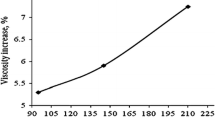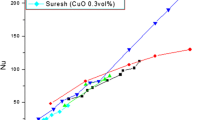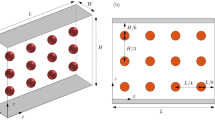Abstract
Nanofluids are produced by dispersing nanoparticles in basefluid. Given its superior thermo-physical properties, nanofluids are gaining increasing attention and are showing promising potential in various applications. Numerous studies have been conducted in the past decade to experimentally and theoretically investigate thermal conductivity. The experimental finding is briefly summarized in this study; however, we do not intend to present a systematic summary of the available references from the literature. The primary objective of this study is to review and summarize the most debated mechanisms for heat conduction in nanofluids, such as the effects of a nanolayer, the Brownian motion of nanoparticles and aggregation, as well as induced convection. Finally, at a low concentration of nanoparticles, nanoconvection is the leading contributor to thermal conductivity enhancement, whereas at a higher concentration, the natural thermal transport along the backbone would aggregate, and the effects of the nanolayer would become significant and become ineligible.
Similar content being viewed by others
References
S. U. S. Choi and J. A. Eastman, Enhancing thermal conductivity of fluids with nanoparticles, International mechanical engineering congress and exhibition, San Francisco, CA (1995) 12–17.
R. Saidur, K. Y. Leong and H. A. Mohammad, A review on applications and challenges of nanofluids, Renewable and Sustainable Energy Reviews, 15 (3) (2011) 1646–1668.
S. Choi, Nanofluids could make cool work of hot truck engines, http://nano.anl.gov/news/highlights/2005_choi.html, February 11 (2005).
R. Zheng, J. Gao, J. Wang and G. Chen, Reversible temperature regulation of electrical and thermal conductivity using liquid-solid phase transitions, Nature communications, 2 (2011) 289.
R. Zheng, J. Gao, J. Wang, S. P. Feng, H. Ohtani, J. Wang and G. Chen, Thermal percolation in stable graphite suspensions, Nano letters, 12 (1) (2012) 188–192.
J. J. Wang, R. T. Zheng, J. W. Gao and G. Chen, Heat conduction mechanisms in nanofluids and suspensions, Nano Today, 7 (2) (2012) 124–136.
S. U. S. Choi, Z. G. Zhang, W. Yu and F. E. Lockwood, E. A. Grulke, Anomalous thermal conductivity enhancement in nanotube suspensions, Applied Physics Letters, 79 (14) (2001) 2252.
P. Keblinski, J. A. Eastman and D. G. Cahill, Nanofluids for thermal transport, Materials Today (36-44) (June 2005).
R. S. Vajjha and D. K. Das, A review and analysis on influence of temperature and concentration of nanofluids on thermophysical properties, heat transfer and pumping power, International Journal of Heat and Mass Transfer, 55 (15–16) (2012) 4063–4078.
W. Yu, D. M. France, J. L. Routbort and S. U. S. Choi, Review and comparison of nanofluid thermal conductivity and heat transfer enhancements, Heat Transfer Engineering, 29 (5) (2008) 432–460.
X.-Q. Wang and A. S. Mujumdar, Heat transfer characteristics of nanofluids: a review, International Journal of Thermal Sciences, 46 (1) (2007) 1–19.
M. Chandrasekar and S. Suresh, A review on the mechanisms of heat transport in nanofluids, Heat Transfer Engineering, 30 (14) (2009) 1136–1150.
S. Krishnamurthy, P. Bhattacharya and P. E. Phelan, Enhanced mass transport in nanofluids, Nano Letters, 6 (3) (2006) 419–423.
J.-K. Kim, J. Y. Jung and Y. T. Kang, Absorption performance enhancement by nanoparticles and chemical surfactants in binary nanofluids, International Journal of Refrigeration, 30 (1) (2007) 50–57.
Y. T. Kang, H. J. Kim and K. I. Lee, Heat and mass transfer enhancement of binary nanofluids for H2O/LiBr falling film absorption process, International Journal of Refrigeration, 31 (5) (2008) 850–856.
I. Torres Pineda, J. W. Lee, I. Jung and Y. T. Kang, CO2 absorption enhancement by methanol-based Al2O3 and SiO2 nanofluids in a tray column absorber, International Journal of Refrigeration, 35 (5) (2012) 1402–1409.
J. W. Lee, J.-Y. Jung, S.-G. Lee and Y. T. Kang, CO2 bubble absorption enhancement in methanol-based nanofluids, International Journal of Refrigeration, 34 (8) (2011) 1727–1733.
C. Pang, W. Wu, W. Sheng, H. Zhang and Y. T. Kang, Mass transfer enhancement by binary nanofluids (NH3/H2O + Ag nanoparticles) for bubble absorption process, International Journal of Refrigeration, 35 (8) (2012) 2240–2247.
S. Özerinç, S. Kakaç and A. G. Yazicioglu, Enhanced thermal conductivity of nanofluids: a state-of-the-art review, Microfluidics and Nanofluidics, 8 (2) (2009) 145–170.
J. H. Lee, S. H. Lee, C. J. Choi, S. P. Jang and S. U. S. Choi, A review of thermal conductivity data, mechanisms and models for nanofluids, International Journal of Micro-Nano Scale Transport, 1 (4) (2010) 269–322.
A. Sergis and Y. Hardalupas, Anomalous heat transfer modes of nanofluids: a review based on statistical analysis, Nanoscale Research Letters, 6 (1) (2011) 391.
R. Saidur, S. N. Kazi, M. S. Hossain, M. M. Rahman and H. A. Mohammed, A review on the performance of nanoparticles suspended with refrigerants and lubricating oils in refrigeration systems, Renewable and Sustainable Energy Reviews, 15 (1) (2011) 310–323.
D. P. Kulkarni, R. S. Vajjha, D. K. Das and D. Oliva, Application of aluminum oxide nanofluids in diesel electric generator as jacket water coolant, Applied Thermal Engineering, 28 (14–15) (2008) 1774–1781.
X. F. Yang and Z. H. Liu, Application of functionalized nanofluid in thermosyphon, Nanoscale Research Letters, 6 (1) (2011) 494.
T. Parametthanuwat, S. Rittidech, A. Pattiya, Y. Ding and S. Witharana, Application of silver nanofluid containing oleic acid surfactant in a thermosyphon economizer, Nanoscale Research Letters, 6 (1) (2011) 315.
A. A. Balandin, Thermal properties of graphene and nanostructured carbon materials, Nature Materials, 10 (2011) 569–581.
X. Wei, H. Zhu, T. Kong and L. Wang, Synthesis and thermal conductivity of Cu2O nanofluids, International Journal of Heat and Mass Transfer, 52 (2009) 4371–4374.
L. Wang and X. Wei, Nanofluids: Synthesis, heat conduction, and extension, Journal of Heat Transfer, 131 (3) (2009) 033102.
K. Kappagantula and M. L. Pantoya, Experimentally measured thermal transport properties of aluminum-polytetrafluoroethylene nanocomposites with grapheme and carbon nanotube additives, International Journal of Heat and Mass Transfer, 55 (2012) 817–824.
C. Pang, J.-Y. Jung, J. W. Lee and Y. T. Kang, Thermal conductivity measurement of methanol-based nanofluids with Al2O3 and SiO2 nanoparticles, International Journal of Heat and Mass Transfer, 55 (21–22) (2012) 5597–5602.
C. Pang, J.-Y. Jung and Y. T. Kang, Thermal conductivity enhancement of Al2O3 nanofluids based on the mixtures of aqueous NaCl solution and CH3OH, International Journal of Heat and Mass Transfer, 56 (1–2) (2013) 94–100.
C. Pang and Y. T. Kang, Enhanced thermal conductivity of nanofluids by nanoconvection and percolation network, International Journal of Heat and Mass Transfer (Submitted) (2013).
C. Pang and Y. T. Kang, A critical review on heat and mass transfer characteristics in nanofluids, Renewable & Sustainable Energy Reviews (submitted) (2013).
C. Pang, J.-Y. Jung and Y. T. Kang, Aggregation based model for thermal conductivity enhancement of nanofluids, International Journal of Heat and Mass Transfer, 72 (2014) 392–399.
M. Kostic and K. C. Simham, Computerized, transient hot-wire thermal conductivity (HWTC) apparatus for nanofluids, Proceedings of the 6th WSEAS International Conference on HEAT and MASS TRANSFER (HMT’09) (2009) 71–78.
P. Vadasz, Rendering the transient hot wire experimental method for thermal conductivity estimation to two-phase systems-theoretical leading order results, Journal of Heat Transfer, 132 (8) (2010) 081601.
J. Fan and L. Wang, Review of heat conduction in nanofluids, Journal of Heat Transfer, 133 (4) (2011) 040801.
S. Lee, S. U. S. Choi, S. Li and J. A. Eastman, Measuring thermal conductivity of fluids containing oxide nanoparticles, Journal of Heat Transfer, 121 (2) (1999) 280–289.
S. K. Das, N. Putra, P. Thiesen and W. Roetzel, Temperature dependence of thermal conductivity enhancement for nanofluids, Journal of Heat Transfer, 125 (4) (2003) 567.
H. Xie, H. Lee, W. Youn and M. Choi, Nanofluids containing multiwalled carbon nanotubes and their enhanced thermal conductivities, Journal of Applied Physics, 94 (8) (2003) 4967.
S. M. S. Murshed, K. C. Leong and C. Yang, Enhanced thermal conductivity of TiO2-water based nanofluids, International Journal of Thermal Sciences, 44 (4) (2005) 367–373.
J. A. Eastman, S. U. S. Choi, S. Li, W. Yu and L. J. Thompson, Anomalously increased effective thermal conductivities of ethylene glycol-based nanofluids containing copper nanoparticles, Applied Physics Letters, 78 (6) (2001) 718.
M. S. Liu, M. C. Lin, I. T. Huang and C. C. Wang, Enhancement of thermal conductivity with carbon nanotube for nanofluids, International Communications in Heat and Mass Transfer, 32 (9) (2005) 1202–1210.
H. Xie, J. Wang, T. Xi, Y. Liu, F. Ai and Q. Wu, Thermal conductivity enhancement of suspensions containing nanosized alumina particles, Journal of Applied Physics, 91 (7) (2002) 4568.
H. U. Kang, S. H. Kim and J. M. Oh, Estimation of thermal conductivity of nanofluid using experimental effective particle volume, Experimental Heat Transfer, 19 (3) (2006) 181–191.
M. Chiesa and S. K. Das, Experimental investigation of the dielectric and cooling performance of colloidal suspensions in insulating media, Colloids and Surfaces A: Physicochemical and Engineering Aspects, 335 (1–3) (2009) 88–97.
A. Karaipekli, A. Sari and K. Kaygusuz, Thermal conductivity improvement of stearic acid using expanded graphite and carbon fiber for energy storage applications, Renewable Energy, 32 (13) (2007) 2201–2210.
W. Yu, H. Xie and D. Bao, Enhanced thermal conductivities of nanofluids containing graphene oxide nanosheets, Nanotechnology, 21 (5) (2010) 055705.
H. Xie, W. Yu, Y. Li and L. Chen, Discussion on the thermal conductivity enhancement of nanofluids, Nanoscale Research Letters, 6 (1) (2011) 124.
Y. Xuan, Q. Li and W. Hu, Aggregate structure and thermal conductivity of nanofluids, AICh E Journal, 49 (4) (2003) 1038–1043.
G. N. Dul’nev and Y. P. Zarichnyak, Thermal conductivity of liquid mixtures, Journal of Engineering Physics, 11 (6) (1966) 747–750.
H. xie, J. Wang, T. Xi, Y. Liu and F. Ai, Dependence of the thermal conductivity of nanoparticle-fluid mixture on the base fluid, Journal of Materials Science Letters, 21 (2002) 1469–1471.
H. A. Mintsa, G. Roy, C. T. Nguyen and D. Doucet, New temperature dependent thermal conductivity data for waterbased nanofluids, International Journal of Thermal Sciences, 48 (2) (2009) 363–371.
S. M. S. Murshed, K. C. Leong and C. Yang, Investigations of thermal conductivity and viscosity of nanofluids, International Journal of Thermal Sciences, 47 (5) (2008) 560–568.
C. H. Chon and K. D. Kihm, Thermal conductivity enhancement of nanofluids by brownian motion, Journal of Heat Transfer, 127 (8) (2005).
R. Prasher, P. E. Phelan and P. Bhattacharya, Effect of aggregation kinetics on the thermal conductivity of nanoscale colloidal solutions (Nanofluid), Nano letters, 6 (7) (2006) 1529–1534.
X. Q. Wang and A. S. Mujumdar, Heat transfer characteristics of nanofluids: a review, International Journal of Thermal Sciences, 46 (1) (2007) 1–19.
P. Keblinski, R. Prasher and J. Eapen, Thermal conductance of nanofluids: is the controversy over?, Journal of Nanoparticle Research, 10 (7) (2008) 1089–1097.
J. Maxwell, Treatise on Electricity and Magnetism, Dover Publications, New York (1954).
D. A. G. Bruggeman, Berechnung verschiedener physikalischer Konstanten von heterogenen Substanzen. I. Dielektrizitätskonstanten und Leitfähigkeiten der Mischkörper aus isotropen Substanzen, Annalen der Physik, 416 (7) (1935) 636–664.
B.-X. Wang, L.-P. Zhou and X.-F. Peng, A fractal model for predicting the effective thermal conductivity of liquid with suspension of nanoparticles, International Journal of Heat and Mass Transfer, 46 (14) (2003) 2665–2672.
R. L. Hamilton and O. K. Crosser, Thermal conductivity of heterogeneous two-component systems, Industrial and Engineering Chemistry Fundamentals, 1 (3) (1962) 187–191.
P. Keblinski, S. R. Phillpot, S. U. S. Choi and J. A. Eastman, Mechanisms of heat flow in suspensions of nano-sized particles (nanofluids), International Journal of Heat and Mass Transfer, 45 (2002) 855–863.
W. Yu and S. U. S. Choi, the role of interfacial layers in the enhanced thermal conductivity of nanofluids-A renovated maxwell model, Journal of Nanoparticle Research, 5 (2003) 167–171.
T. Hashimoto, M. Shibayama and H. Kawai, Domainboundary structure of styrene-isoprene block copolymer films cast from solution 4. Molecular-weight dependence of lamellar microdomains, Macromolecules, 13 (1980) 1237–1247.
W. Yu and S. U. S. Choi, The role of interfacial layers in the enhanced thermal conductivity of nanofluids: A renovated Hamilton-Crosser model, Journal of Nanoparticle Research, 6 (2004) 355–361.
K. C. Leong, C. Yang and S. M. S. Murshed, A model for the thermal conductivity of nanofluids-the effect of interfacial layer, Journal of Nanoparticle Research, 8 (2) (2006) 245–254.
H. Xie, M. Fujii and X. Zhang, Effect of interfacial nanolayer on the effective thermal conductivity of nanoparticle-fluid mixture, International Journal of Heat and Mass Transfer, 48 (14) (2005) 2926–2932.
C.-J. Yu, A. G. Richter, A. Datta, M. K. Durbin and P. Dutta, Observation of molecular layering in thin liquid films using X-RAY REflECtivity, Physical Review Letters, 82 (11) (1999) 2326–2329.
S. P. Jang and S. U. S. Choi, Role of Brownian motion in the enhanced thermal conductivity of nanofluids, Applied Physics Letters, 84 (21) (2004) 4316.
J. Koo and C. Kleinstreuer, A new thermal conductivity model for nanofluids, J. Nanopart. Research, 6 (6) (2004) 577–588.
R. Prasher, P. Bhattacharya and P. Phelan, Thermal conductivity of nanoscale colloidal solutions (Nanofluids), Physical Review Letters, 94 (2) (2005).
D. Kumar, H. Patel, V. Kumar, T. Sundararajan, T. Pradeep and S. Das, Model for heat conduction in nanofluids, Physical Review Letters, 93 (14) (2004).
H. E. Patel, T. Sundararajan and S. K. Das, A cell model approach for thermal conductivity of nanofluids, Journal of Nanoparticle Research, 10 (1) (2007) 87–97.
J. Eapen, R. Rusconi, R. Piazza and S. Yip, The classical nature of thermal conduction in nanofluids, Journal of Heat Transfer, 132 (10) (2010) 102402.
Y. Feng, B. Yu, P. Xu and M. Zou, The effective thermal conductivity of nanofluids based on the nanolayer and the aggregation of nanoparticles, Journal of Physics D: Applied Physics, 40 (10) (2007) 3164–3171.
B. Yang, Thermal conductivity equations based on brownian motion in suspensions of nanoparticles (Nanofluids), Journal of Heat Transfer, 130 (4) (2008) 042408.
R. Prasher, P. E. Phelan and P. Bhattacharya, Effect of aggregation kinetics on the thermal conductivity of nanoscale colloidal solutions (nanofluid), Nano Letters., 6 (7) (2006) 1529–1534.
J. W. Gao, R. T. Zheng, H. Ohtani, D. S. Zhu and G. Chen, Experimental investigation of heat conduction mechanisms in nanofluids-clue on clustering, Nano letters, 9 (12) (2009) 4128–4132.
W. Evans, R. Prasher, J. Fish, P. Meakin, P. Phelan and P. Keblinski, Effect of aggregation and interfacial thermal resistance on thermal conductivity of nanocomposites and colloidal nanofluids, International Journal of Heat and Mass Transfer, 51 (5–6) (2008) 1431–1438.
C.-W. Nan, R. Birringer, D. R. Clarke and H. Gleiter, Effective thermal conductivity of particulate composites with interfacial thermal resistance, Journal of Applied Physics, 81 (10) (1997) 6692.
R. Prasher, P. Bhattacharya and P. E. Phelan, Brownianmotion-based convective-conductive model for the effective thermal conductivity of nanofluids, Journal of Heat Transfer, 128 (6) (2006) 588.
G. Chen, Nanoscale energy transport and conversion: A parallel treatment of electrons, molecules, phonons, and photons, Oxford University Press, USA, March 3 (2005).
O. Wilson, X. Hu, D. Cahill and P. Braun, Colloidal metal particles as probes of nanoscale thermal transport in fluids, Physical Review B, 66 (22) (2002).
A. G. Every, Y. Tzou, D. P. H. Hasselman and R. Raj, The Effect of microstructure on the thermal conductivity of particulate ZnS-diamond composites, Journal of Materials Research (1990).
R. Prasher, Acoustic mismatch model for thermal contact resistance of van der Waals contacts, Applied Physics Letters, 94 (4) (2009) 041905.
X. Wang, X. Xu and S. U. S. Choi, Thermal conductivity of nanoparticle-fluid mixture, Journal of Thermophysics and Heat Transfer, 13 (4) (1999) 474–480.
P. D. Shima, J. Philip and B. Raj, Role of microconvection induced by Brownian motion of nanoparticles in the enhanced thermal conductivity of stable nanofluids, Applied Physics Letters, 94 (22) (2009) 223101.
W. Evans, J. Fish and P. Keblinski, Role of Brownian motion hydrodynamics on nanofluid thermal conductivity, Applied Physics Letters, 88 (9) (2006) 093116.
G. Domingues, S. Volz, K. Joulain and J.-J. Greffet, Heat transfer between two nanoparticles through near field interaction, Physical Review Letters, 94 (8) (2005).
P. Ben-Abdallah, Heat transfer through near-field interactions in nanofluids, Applied Physics Letters, 89 (11) (2006) 113117.
S. Shen, A. Narayanaswamy and G. Chen, Surface phonon polaritons mediated energy transfer between nanoscale gaps, Nano letters, 9 (8) (2009) 2909–2913.
Author information
Authors and Affiliations
Corresponding author
Additional information
Recommended by Editor Haecheon Choi
Rights and permissions
About this article
Cite this article
Pang, C., Lee, J.W., Hong, H. et al. Heat conduction mechanism in nanofluids. J Mech Sci Technol 28, 2925–2936 (2014). https://doi.org/10.1007/s12206-014-0645-x
Received:
Revised:
Accepted:
Published:
Issue Date:
DOI: https://doi.org/10.1007/s12206-014-0645-x




